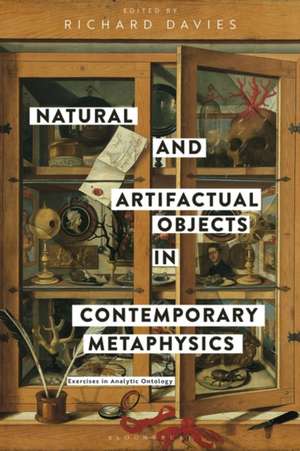Natural and Artifactual Objects in Contemporary Metaphysics: Exercises in Analytic Ontology
Editat de Professor Richard Daviesen Limba Engleză Paperback – 22 iul 2020
| Toate formatele și edițiile | Preț | Express |
|---|---|---|
| Paperback (1) | 224.21 lei 6-8 săpt. | |
| Bloomsbury Publishing – 22 iul 2020 | 224.21 lei 6-8 săpt. | |
| Hardback (1) | 654.45 lei 6-8 săpt. | |
| Bloomsbury Publishing – 9 ian 2019 | 654.45 lei 6-8 săpt. |
Preț: 224.21 lei
Preț vechi: 288.61 lei
-22% Nou
Puncte Express: 336
Preț estimativ în valută:
42.91€ • 44.63$ • 35.42£
42.91€ • 44.63$ • 35.42£
Carte tipărită la comandă
Livrare economică 14-28 aprilie
Preluare comenzi: 021 569.72.76
Specificații
ISBN-13: 9781350175433
ISBN-10: 1350175439
Pagini: 248
Dimensiuni: 156 x 234 mm
Greutate: 0.35 kg
Editura: Bloomsbury Publishing
Colecția Bloomsbury Academic
Locul publicării:London, United Kingdom
ISBN-10: 1350175439
Pagini: 248
Dimensiuni: 156 x 234 mm
Greutate: 0.35 kg
Editura: Bloomsbury Publishing
Colecția Bloomsbury Academic
Locul publicării:London, United Kingdom
Caracteristici
Conceptualizes
the
relation
between
the
natural
and
the
conventional
Notă biografică
Richard
Daviesis
a
Professor
of
Philosophy
at
University
of
Bergamo,
Italy.
Cuprins
Introduction:
Carving
Nature
at
the
Joints,
Richard
Davies(University
of
Bergamo,
Italy)Part
I:
Does
Nature
Carve
Itself?1.
Mental
acts,
externalism
andfiatobjects:
an
Ockhamist
solution,
Riccardo
Fedriga(University
of
Bologna,
Italy)2.
Is
the
World
really
a
World
of
Objects?
A
Note
on
Quinean
Ontology,Antonio
Rainone
("L'Orientale"
University
of
Naples,
Italy)3.
Spatial
Fictionalism.
A
Solution
of
the
Grounding
Problem,
Nicola
Piras(University
of
Sassari,
Italy)4.
Talking
about
Properties:
A
Couple
of
Doubts
about
Hofweber's
Internalist
View,
Elisa
Paganini(State
University
of
Milan,
Italy)Part
II:
Where
Do
Limits
Lie?5.
The
Eye
of
the
Needle:
Seeing
Holes,
Clotilde
Calabi(State
University
of
Milan,
Italy)6.
Bona
Fideness
of
Material
Entities
and
their
Boundaries,Lars
Vogt
(University
of
Bonn,
Germany)7.
A
Conceptualist
View
in
the
Metaphysics
of
Species,
Ciro
De
Florio
and
Aldo
Frigerio(both
Catholic
University
of
Milan,
Italy)Part
III:
Where
Do
Tools
Come
From?8.
Artifacts
andfiatobjects:
two
families
apart?,
Massimiliano
Carrara
and
Marzia
Soavi(both
University
of
Padua,
Italy)9.
The
Semantics
of
Artifactual
Words,
Marco
Santambrogio(University
of
Parma,
Italy)10.
Are
linguistic
objectsfiatorbona
fide?
An
ancient
proposal,
Maddalena
Bonelli(University
of
Bergamo,
Italy)Part
IV:
What
Does
Mind-Dependency
Depend
On?11.
Leibniz's
principle
and
psycho-neural
identity,
Andrea
Bottani
and
Alfredo
Paternoster(both
University
of
Bergamo,
Italy)12.
Do
we
exist?
Mereological
nihilism,
collective
thinking
and
dualism,
Alfredo
Tomasetta(University
School
for
Advanced
Studies
IUSS,
Pavia)AbstractsIndex
of
NamesIndex
of
Principal
Subjects
Recenzii
The
13
essays
Davies
(Univ.
of
Bergamo,
Italy)
has
gathered
discuss
problems
arising
from
the
distinction
between
natural
and
nonnatural
objects
and
between
language-the
supreme
human
artifact-and
language-indifferent
nature
.
Summing
Up:
Recommended.
Researchers
and
faculty.
When philosophers deal with ontology, they still turn their attentions primarily to ideal worlds constructed out of sets, or bare particulars, or atomless gunk. Outside philosophy, in contrast, ontology is being vigorously applied to real-world problems in areas such as genomics, engineering design, materials science or geopolitics. This groundbreaking volume is the first major study of the philosophical issues brought to light by this new applied ontology. It will be an indispensable resource for the work that is to come.
Everybody agrees: there is a big difference between the natural and the artifactual, between the mind-independent features of reality and the products of our worldmaking practices. The challenge, as the essays in this book admirably show, is where to draw the line, and how to do so without begging the question. A rich, engaging, highly original contribution to the classical debate between metaphysical realism and constructivism.
When philosophers deal with ontology, they still turn their attentions primarily to ideal worlds constructed out of sets, or bare particulars, or atomless gunk. Outside philosophy, in contrast, ontology is being vigorously applied to real-world problems in areas such as genomics, engineering design, materials science or geopolitics. This groundbreaking volume is the first major study of the philosophical issues brought to light by this new applied ontology. It will be an indispensable resource for the work that is to come.
Everybody agrees: there is a big difference between the natural and the artifactual, between the mind-independent features of reality and the products of our worldmaking practices. The challenge, as the essays in this book admirably show, is where to draw the line, and how to do so without begging the question. A rich, engaging, highly original contribution to the classical debate between metaphysical realism and constructivism.
